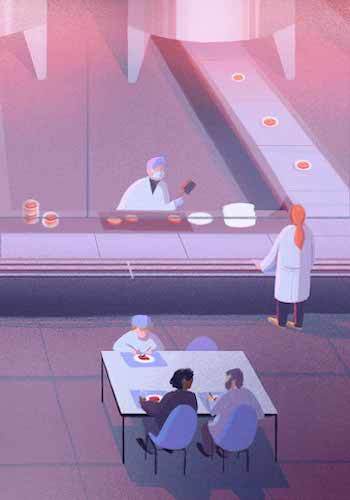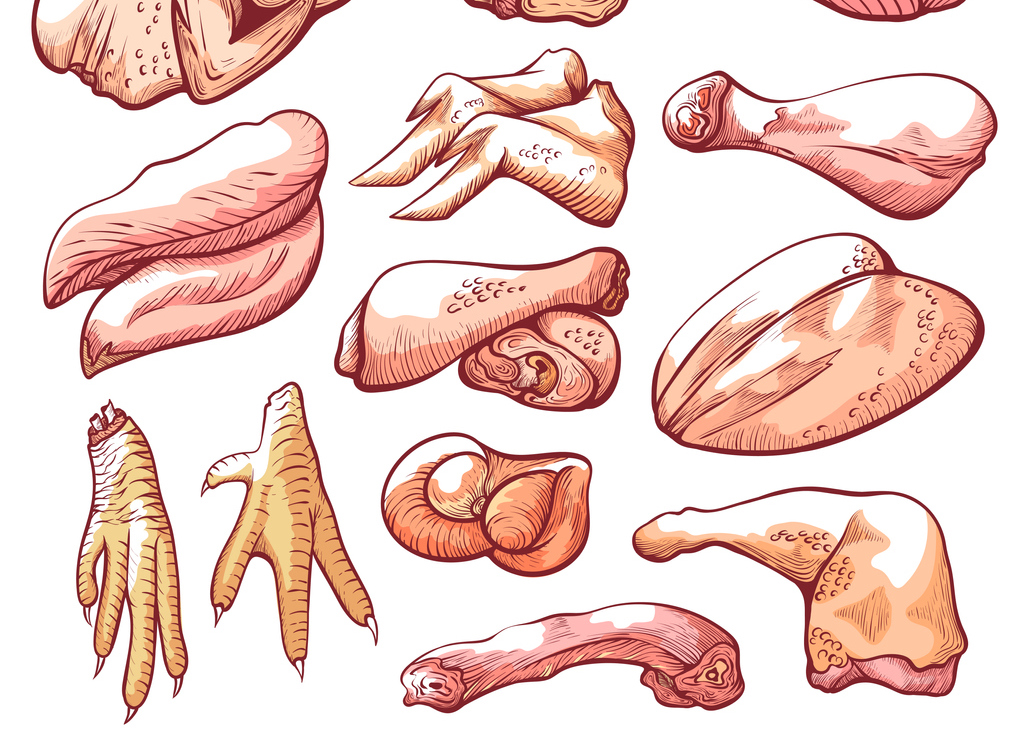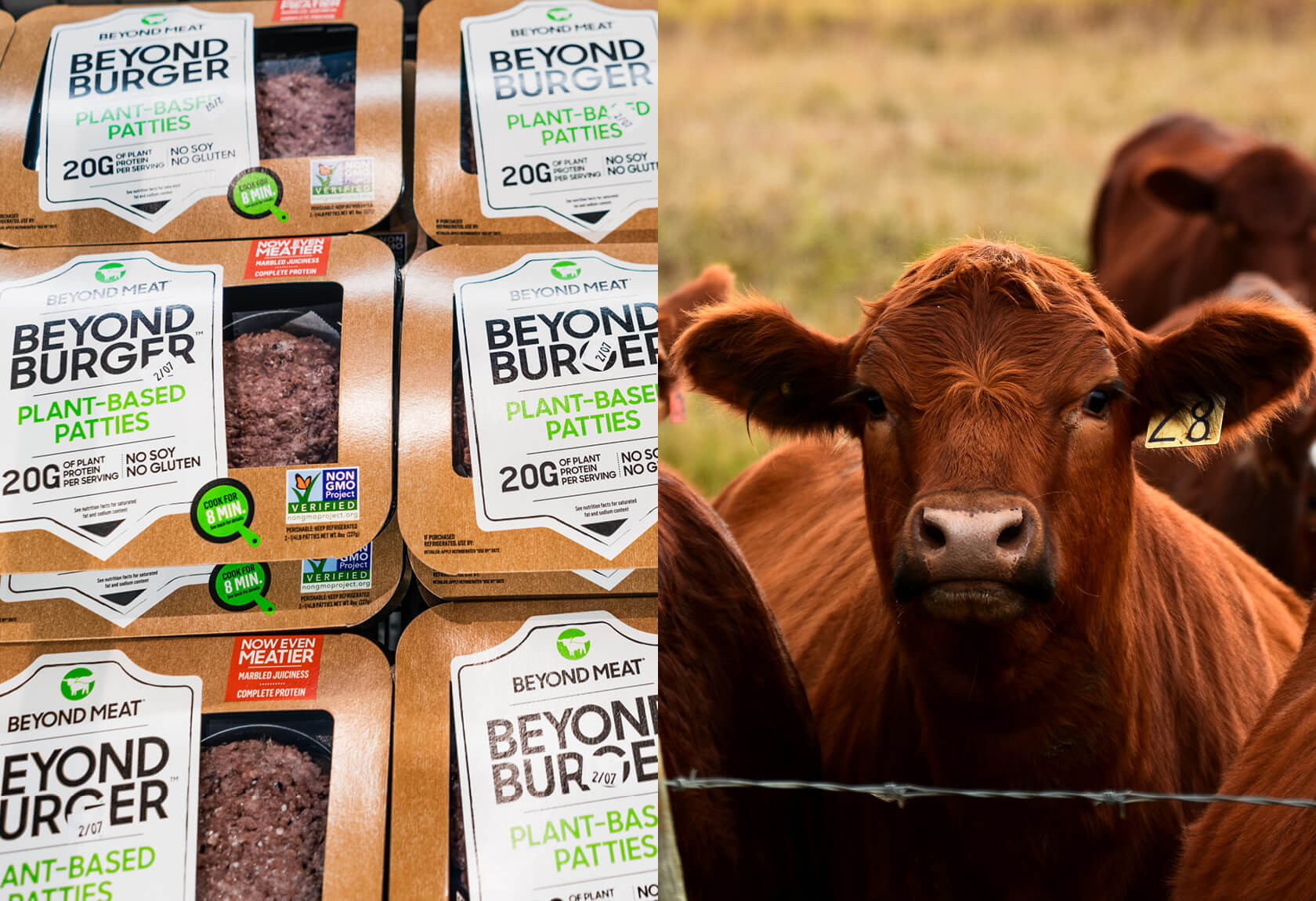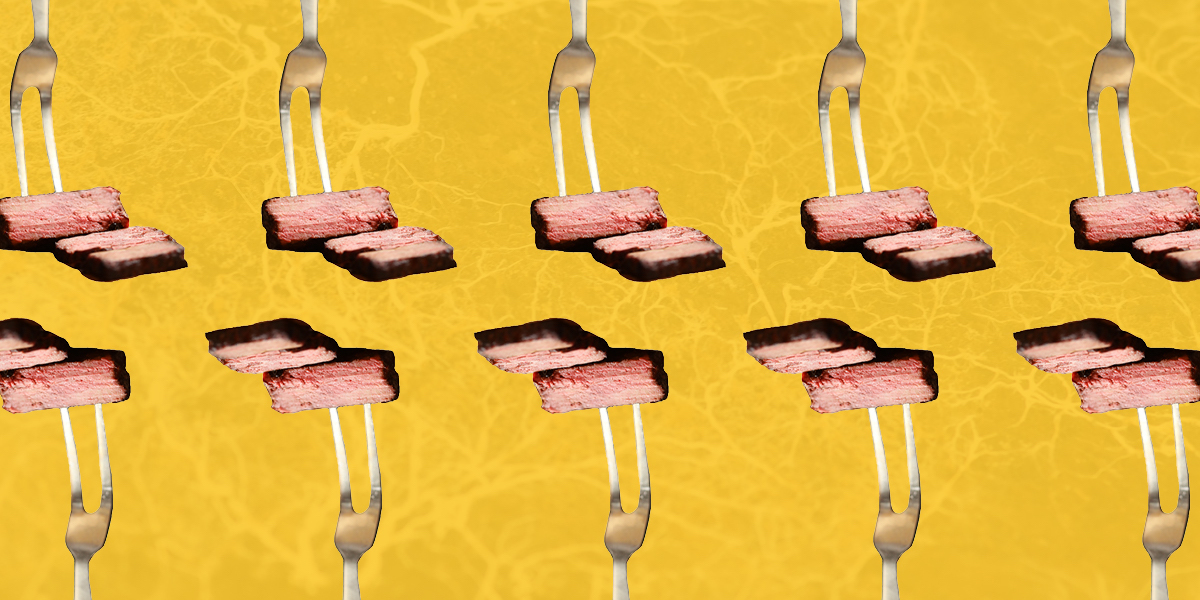Splashy headlines have long overshadowed inconvenient truths about biology and economics. Now, extensive new research suggests the industry may be on a billion-dollar crash course with reality.
Paul Wood didn’t buy it.
For years, the former pharmaceutical industry executive watched from the sidelines as biotech startups raked in venture capital, making bold pronouncements about the future of meat. He was fascinated by their central contention: the idea that one day, soon, humans will no longer need to raise livestock to enjoy animal protein. We’ll be able to grow meat in giant, stainless-steel bioreactors—and enough of it to feed the world. These advancements in technology, the pitch went, would fundamentally change the way human societies interact with the planet, making the care, slaughter, and processing of billions of farm animals the relic of a barbaric past.
Update, October 7, 2021: This story was updated to include additional comments from Future Meat Technologies.
Illustrations by Cristina Estanislao
It’s a digital-era narrative we’ve come to accept, even expect: Powerful new tools will allow companies to rethink everything, untethering us from systems we’d previously taken for granted. Countless news articles have suggested that a paradigm shift driven by cultured meat is inevitable, even imminent. But Wood wasn’t convinced. For him, the idea of growing animal protein was old news, no matter how science-fictional it sounded. Drug companies have used a similar process for decades, a fact Wood knew because he’d overseen that work himself.
For four years, Wood, who has a PhD in immunology, served as the executive director of global discovery for Pfizer Animal Health. (His division was later spun off into Zoetis, today the largest animal health company in the world.) One of his responsibilities was to oversee production of vaccines, which can involve infecting living cells with weakened virus strains and inducing those cells to multiply inside large bioreactors. In addition to yielding large quantities of vaccine-grade viruses, this approach also creates significant amounts of animal cell slurry, similar to the product next-generation protein startups want to process further into meat. Wood knew the process to be extremely technical, resource-intensive, and expensive. He didn’t understand how costly biomanufacturing techniques could ever be used to produce cheap, abundant human food.
In March of this year, he hoped he’d finally get his answer. That month, the Good Food Institute (GFI), a nonprofit that represents the alternative protein industry, published a techno-economic analysis (TEA) that projected the future costs of producing a kilogram of cell-cultured meat. Prepared independently for GFI by the research consulting firm CE Delft, and using proprietary data provided under NDA by 15 private companies, the document showed how addressing a series of technical and economic barriers could lower the production price from over $10,000 per pound today to about $2.50 per pound over the next nine years—an astonishing 4,000-fold reduction.
Costs for cell-cultured meat need to come down quickly. Most of us have a limited appetite for 50-dollar lab-grown chicken nuggets.
In the press push that followed, GFI claimed victory. “New studies show cultivated meat can have massive environmental benefits and be cost-competitive by 2030,” it trumpeted, suggesting that a new era of cheap, accessible cultured protein is rapidly approaching. The finding is critical for GFI and its allies. If private, philanthropic, and public sector investors are going to put money into cell-cultured meat, costs need to come down quickly. Most of us have a limited appetite for 50-dollar lab-grown chicken nuggets.
With its TEA findings in hand, GFI has worked tirelessly to argue for massive public investment. Its top policy recommendation, according to GFI’s in-depth analysis of the TEA results, is aimed at “forward-thinking” governments: They “should increase public funds for R & D into cultivated meat technology” in order to “seize the opportunity and reap the benefits of becoming global leaders” in the space. In April, just six weeks later, that message was amplified by The New York Times. In a column called “Let’s Launch a Moonshot for Meatless Meat,” Ezra Klein, a co-founder of Vox who is now one of the Times’s most visible and influential writers, argued that the U.S. government should invest billions to improve and scale both plant-based meat alternatives (like the Impossible Burger) and cultivated meat.
Bruce Friedrich, GFI’s founder and CEO, appeared in the story to argue that the need for significant public investment was urgent and necessary.
“If we leave this endeavor to the tender mercies of the market there will be vanishingly few products to choose from and it’ll take a very long time,” he told Klein. The message was clear: If we want to save the planet, we should double down on cultured meat.
Cultivated meat companies have repeatedly missed product launch deadlines
For years, companies have said that “meat without slaughter” is right around the corner. But when will products actually be on store shelves? The answer always seems to be the same: just a few years from now. Below, a map of product launch predictions compiled by staffers at Mother Jones, first included as part of Tom Philpott’s recent piece on new doubts about the impracticality of cultured meat. This infographic is best viewed on a desktop. Hover over a bar for more information.
Mother Jones
Wood couldn’t believe what he was hearing. In his view, GFI’s TEA report did little to justify increased public investment. He found it to be an outlandish document, one that trafficked more in wishful thinking than in science. He was so incensed that he hired a former Pfizer colleague, Huw Hughes, to analyze GFI’s analysis. Today, Hughes is a private consultant who helps biomanufacturers design and project costs for their production facilities; he’s worked on six sites devoted to cell culture at scale. Hughes concluded that GFI’s report projected unrealistic cost decreases, and left key aspects of the production process undefined, while significantly underestimating the expense and complexity of constructing a suitable facility.
In an interview by phone, Wood wondered if GFI was being disingenuous—or if the organization was simply naive.
“After a while, you just think: Am I going crazy? Or do these people have some secret sauce that I’ve never heard of?” Wood said. “And the reality is, no—they’re just doing fermentation. But what they’re saying is, ‘Oh, we’ll do it better than anyone else has ever, ever done.”
In fact, GFI was well aware of Wood’s line of criticism. Several months earlier, Open Philanthropy—a multi-faceted research and investment entity with a nonprofit grant-making arm, which is also one of GFI’s biggest funders—completed a much more robust TEA of its own, one that concluded cell-cultured meat will likely never be a cost-competitive food. David Humbird, the UC Berkeley-trained chemical engineer who spent over two years researching the report, found that the cell-culture process will be plagued by extreme, intractable technical challenges at food scale. In an extensive series of interviews with The Counter, he said it was “hard to find an angle that wasn’t a ludicrous dead end.”
Humbird likened the process of researching the report to encountering an impenetrable “Wall of No”—his term for the barriers in thermodynamics, cell metabolism, bioreactor design, ingredient costs, facility construction, and other factors that will need to be overcome before cultivated protein can be produced cheaply enough to displace traditional meat.
“And it’s a fractal no,” he told me. “You see the big no, but every big no is made up of a hundred little nos.”

Alternative protein company Eat Just started selling small amounts of cultured chicken, pictured left, in Singapore earlier this year.
But the question isn’t whether companies can culture animal protein in the lab—drug companies have been doing that for decades. It’s whether that approach can actually feed a meaningful number of people.
Courtesy of Eat Just
GFI vetted Humbird’s report before publication and made extensive suggestions for revision. Its own TEA, released a few months later, painted a much more optimistic picture. With its own results in hand, GFI continues to urge world governments to throw money into cultivated meat. If they don’t act soon, according to one recent press release, those nations risk being “left behind.”
Who’s right? Is cultured meat our best hope to save the climate, a billion-dollar boondoggle, or something in between? Will it ever make sense to produce food the way we currently make our drugs?
The stakes couldn’t be higher. In August, the United Nations released a nearly 4,000-page report amounting to what it called a “code red for humanity”: Unless the world’s nations make a vast, coordinated effort to stop burning fossil fuels and razing forests, we’ll find ourselves locked into an even more dire, unforgiving future than the one we’re facing now. At a time when bold environmental solutions are needed, we can only afford to direct public and private investment toward solutions that actually work. But without looking more closely at the fundamentals—something media has largely declined to do—we can’t know whether cultured meat is our salvation or an expensive distraction.

1. The biggest small factories in the world
It’s the beginning of a shift in human thinking, enabled by biotechnology: Rather than raise entire animals, we might only grow the parts we eat. Why spend energy growing the complex, sentient structures we call cattle—complete with bones, horns, hooves, and vital organs—when we only want the finished steak? Cultivating meat inside bioreactors eliminates those inconveniences, doing away with the troublesome task of growing a body, of sustaining a consciousness.
Gram for gram, animals are a wildly inefficient vehicle for producing edible protein (as advocates for cultured meat like to point out). Cattle consume roughly 25 calories of plant material for every calorie of edible protein they produce, according to some estimates. Even chickens, the most efficient form of livestock from a feed perspective, eat 9 to 10 calories of food for every calorie of edible protein produced. Friedrich, the director of GFI, has said that’s like throwing away 8 plates of pasta for every one plate we eat. He’s right—though it’s not only wasteful. Our over-consumption of meat is inherently linked to the global over-production of grains, one of the primary drivers of deforestation and biodiversity loss worldwide. Next time you’re wondering why Brazilian farmers are burning down the rainforest to plant more soy, think of the world’s 1 billion cattle, each one eating many times its weight in grass, legumes, and grain over the course of its short life.
In contrast, the disembodied economics of cultivated meat could allow for huge production advantages, at least theoretically. According to the Open Philanthropy report, a mature, scaled-up industry could eventually achieve a ratio of only three to four calories in for every calorie out, compared to the chicken’s 10 and the steer’s 25. That would still make cultured meat much more inefficient compared to just eating plants themselves; we’d dump two plates of pasta for every one we eat. And the cells themselves might still be fed on a diet of commodity grains, the cheapest and most environmentally destructive inputs available. But it would represent a major improvement.
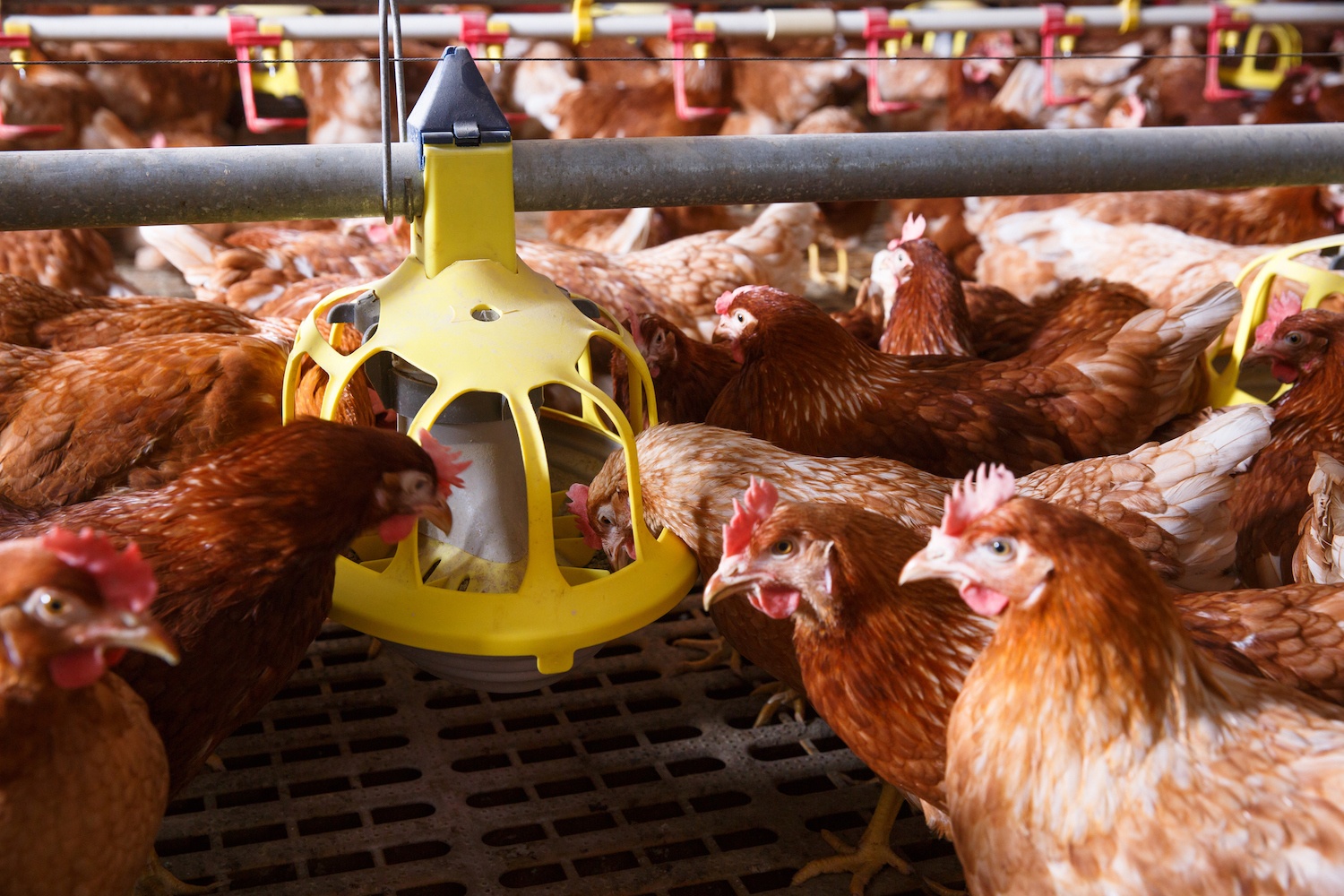
Chickens, the most efficient form of livestock from a feed perspective, still need to eat nine to 10 calories of food for every calorie of edible protein produced.
Cultured meat could be much more efficient—but there’s a catch.
But cultivated meat’s gains in feed efficiency give rise to new inefficiency—the need for intensive, sophisticated machinery, and lots of it.
The analysis that GFI commissioned laid out a vision of this future, predicting the emergence of a new kind of mega-facility with the power to transform our eating habits forever. The idea was to project what cultivated meat production will need to look like in the year 2030—in terms of scale and cost—if it is going to make meaningful progress toward displacing animal agriculture. In other words, if meat without slaughter is ever going to move out of the realm of exclusive press tastings and onto supermarket shelves, it will need to happen through facilities like the one the report described.
GFI’s imagined facility would be both unthinkably vast and, well, tiny. According to the TEA, it would produce 10,000 metric tons—22 million pounds—of cultured meat per year, which sounds like a lot. For context, that volume would represent more than 10 percent of the entire domestic market for plant-based meat alternatives (currently about 200 million pounds per year in the U.S., according to industry advocates). And yet 22 million pounds of cultured protein, held up against the output of the conventional meat industry, barely registers. It’s only about .0002, or one-fiftieth of one percent, of the 100 billion pounds of meat produced in the U.S. each year. JBS’s Greeley, Colorado beefpacking plant, which can process more than 5,000 head of cattle a day, can produce that amount of market-ready meat in a single week.
Even at a projected cost of $450 million, one hypothetical cultured meat factory wouldn’t come much cheaper than a traditional slaughterhouse—but it would produce a lot less meat.
And yet, at a projected cost of $450 million, GFI’s facility might not come any cheaper than a large conventional slaughterhouse. With hundreds of production bioreactors installed, the scope of high-grade equipment would be staggering. According to one estimate, the entire biopharmaceutical industry today boasts roughly 6,300 cubic meters in bioreactor volume. (1 cubic meter is equal to 1,000 liters.) The single, hypothetical facility described by GFI would require nearly a third of that, just to make a sliver of the nation’s meat.
The process, according to GFI, would begin with a 1.5-milliliter vial of production-optimized animal cells (the report doesn’t specify which livestock species). Those cells would be used to inoculate a 250-ml flask, a vessel smaller than a can of soda. The rest of the flask would be filled with a specially formulated growth medium, a nutrient-dense broth of purified water, salts, glucose, amino acids, and “growth factors”—the hormones, recombinant proteins, cytokines and other substances that regulate cell development and metabolism. In a sense, the role of this liquid is to approximate good old-fashioned blood, the fluid that delivers nutrients and hormones to cells inside a living animal’s body.
Slowly, the initial seed cells would begin to multiply. After 10 days, according to GFI, the cells graduate to their first bioreactor, a small, 50-liter model. In another 10 days, they would move to a much larger, 12,500-liter stirred batch reactor, the kind of steel vessel you might expect to see in a brewery, capable of holding the same volume as a backyard swimming pool. This gradual progression is necessary; you can’t just throw a small amount of cells into a large bioreactor and hope they’ll start dividing. Cells are “fastidious,” Hughes told me, and have strict metabolic requirements for growth, including oxygen tension. Because of this characteristic, more fluid is pumped into the reactor as cells multiply, maintaining a specific ratio of fluid to cells. Any cultured meat facility, real or imagined, will likely need to operate this way: with a graduated series of ever-larger reactors, like a sequence of Russian dolls.
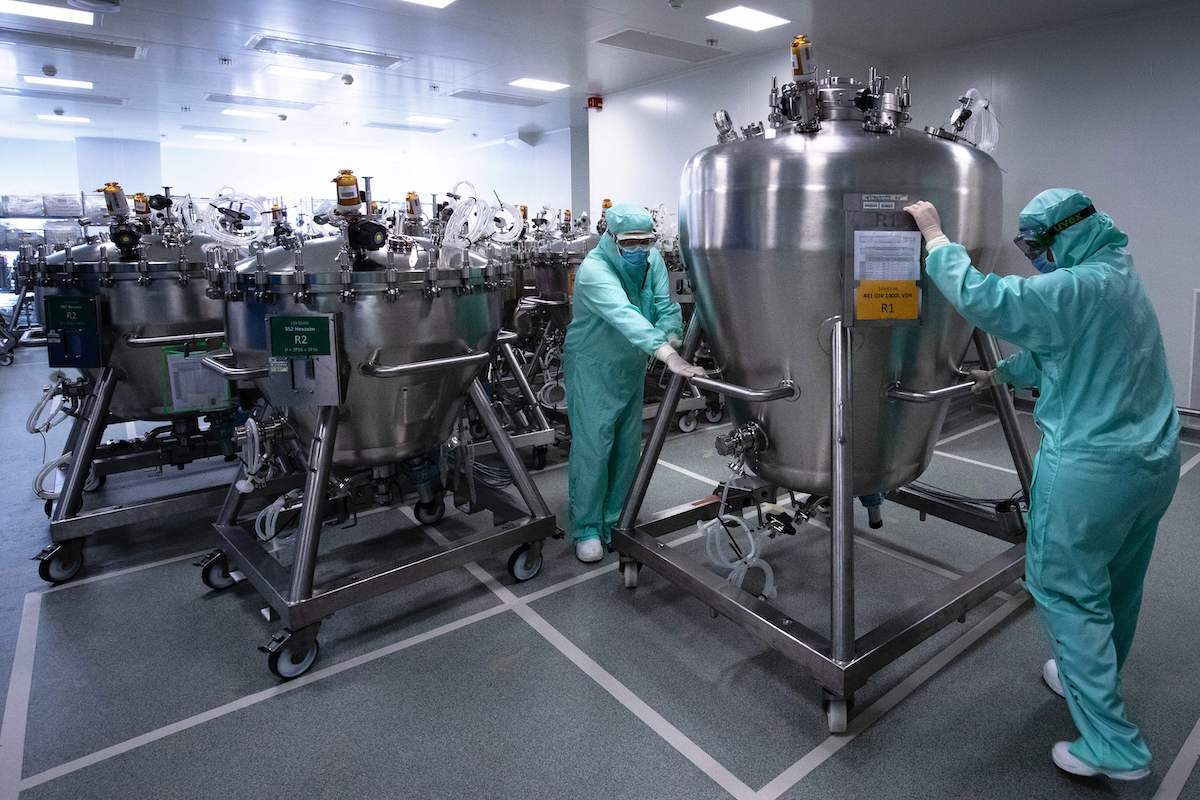
Cell-cultured meat production is similar to a decades-old process used to manufacture certain vaccines. Left, lab technicians dedicated to the vaccines formulation prepare vaccines at a French pharmaceutical company Sanofi’s world distribution center in Val-de-Reuil, France.
JOEL SAGET/AFP via Getty Images
Up until this point, GFI’s imagined production line looks somewhat like what you might encounter in a present-day vaccine-manufacturing plant. The Oxford-Astrazeneca and Johnson & Johnson Covid-19 vaccines, for instance, are produced using a related method (through lines of cultured human kidney and retinal cells, respectively). But GFI’s version assumes an additional step that would further process the cells into human food. The large, stirred-batch reactor will be harvested three times to fill four smaller perfusion reactors, more sophisticated vessels that help the cells mature and differentiate. Each perfusion reactor would ultimately deliver a total of 770 kilograms of cultivated meat, slightly more than the weight of a single live steer before slaughter—this time without the bones and gristle.
It’s a complex, precise, energy-intensive process, but the output of this single bioreactor train would be comparatively tiny. The hypothetical factory would need to have 130 production lines like the one I’ve just described, with more than 600 bioreactors all running simultaneously. Nothing on this scale has ever existed—though if we wanted to switch to cultivated meat by 2030, we’d better start now. If cultured protein is going to be even 10 percent of the world’s meat supply by 2030, we will need 4,000 factories like the one GFI envisions, according to an analysis by the trade publication Food Navigator. To meet that deadline, building at a rate of one mega-facility a day would be too slow.
All of those facilities would also come with a heart-stopping price tag: a minimum of $1.8 trillion, according to Food Navigator. That’s where things get complicated. It’s where critics say—and even GFI’s own numbers suggest—that cell-cultured meat may never be economically viable, even if it’s technically feasible.
2. A buried report?
In 2015, Open Philanthropy publicly acknowledged being vexed by the problem of cultured meat. In a long, detailed post on its website, the organization summarized everything it knew—exploring whether the emerging technology was a potentially transformative solution worthy of serious investment, or something more far-fetched. After wrestling with a number of in-the-weeds issues, from sterility challenges to scaffolding designs, Open Philanthropy concluded that it simply didn’t have enough data to draw a conclusion. “There is essentially no industrial data around cost of scaling up cell production,” it wrote.
In 2018, Open Philanthropy itself stepped in to fill that gap, hiring Humbird to do a robust analysis of cultivated meat’s potential. He was the right guy. After getting his PhD in chemical engineering from UC Berkeley in 2004, Humbird used his training to go into the business of rigorous, scientifically informed predictions. Today, in addition to his work as a private-sector consultant, Humbird provides techno-economic analyses for the National Renewable Energy Laboratory (NREL), a renowned federally funded research center in Golden, Colorado. Most of NREL’s engineers use U.S. Department of Energy money to conceive, test, and improve upon novel green energy technologies. Humbird’s job is to look into the crystal ball. He’s one of the experts NREL contracts to figure out which approaches are viable at scale, how much they would cost, and ultimately if the government should fund them.
Humbird spent more than two years preparing his analysis for Open Philanthropy. The resulting document, which clocks in at 100 single-spaced pages with notes and appendices, is the most comprehensive public study of the challenges cultured meat companies will face. (An abridged, formally peer-reviewed version has since appeared in the journal Biotechnology and Bioengineering.) Their future doesn’t look good. Humbird worked off the assumption that the industry would grow to produce 100 kilotons per year worldwide—roughly the amount of plant-based “meat” produced in 2020. He found that even given those economies of scale, which would lower input and material costs to prices that don’t exist today, a facility producing roughly 6.8 kilotons of cultured meat per year would fail to create a cost-competitive product. Using large, 20,000 L reactors would result in a production cost of about $17 per pound of meat, according to the analysis. Relying on smaller, more medium-efficient perfusion reactors would be even pricier, resulting in a final cost of over $23 per pound.
Based on Humbird’s analysis of cell biology, process design, input expenses, capital costs, economies of scale, and other factors, these figures represent the lowest prices companies can expect. And if $17 per pound doesn’t sound too high, consider this: The final product would be a single-cell slurry, a mix of 30 percent animal cells and 70 percent water, suitable only for ground-meat-style products like burgers and nuggets. With markups being what they are, a $17 pound of ground cultivated meat at the factory quickly becomes $40 at the grocery store—or a $100 quarter-pounder at a restaurant. Anything resembling a steak would require additional production processes, introduce new engineering challenges, and ultimately contribute additional expense.
“It was hard to find an angle that wasn’t a ludicrous dead end.”
Though Humbird lays out his case with an unprecedented level of technical detail, his argument can be boiled down simply: The cost of cultivation facilities will always be too burdensome, and the cost of growth media will always be too high, for the economics of cultured meat to make sense. It’s a stark finding, one that’s unusually unequivocal for a scientific document—and it should have made waves in the alternative protein sphere.
Instead, few people found out about it. On December 28, 2020, heading into the New Year’s Eve holiday weekend, Humbird quietly uploaded his paper to an open-source archive for process engineering studies. As of this writing, Open Philanthropy has not referenced its groundbreaking findings on social media or its website, not even on its pages devoted to animal agriculture.
Open Philanthropy declined to be interviewed for this story. “We’ll pass on an interview in part because the full implications for grantmaking and impact investment strategy are not totally settled,” wrote Michael Levine, the organization’s communications officer, in an email.
Levine did note that Open Philanthropy continues to fund “a variety of efforts to help the food industry transition from suffering-intense factory farming,” including GFI’s work.
“We hope that Dr. Humbird’s report helps other grantmakers and investors make informed plans about the future of this industry,” he concluded.
If those grantmakers and investors are put off by the technical complexity of the report, Humbird was happy to sum up his findings more bluntly.
“Clearly, I don’t think cultured meat has legs,” he told me. “I think I make that clear in the paper, if not in such colloquial terms. But it seems like a bunch of hooey to me.”

3. So big and so clean
GFI was keenly aware of Humbird’s findings before they were even published, vetting a draft of his paper and making extensive suggestions for revision. Some of those suggestions, Humbird said, were “inconsistent with good industrial bioprocess design practice.” GFI representatives also recommended he provide more detail about his calculation of capital costs. This feedback, combined with comments from his own colleagues, led him to perform another painstaking layer of analysis, and ultimately to estimate lower project and equipment costs in his updated case studies—though some commenters with GFI, Humbird said, went on to complain about how high those costs still were.
“The July draft was coming out at a hundred bucks a kilo,” he said, or around $45 per pound. “I gave a little more leeway in everything I did. All the other changes to the newer draft brought the costs down from a hundred—but still, much too high.”
But while Humbird’s work begins with an open-ended question—if cultured meat scaled to a global volume of 100 kilotons per year, what would it cost?—GFI’s own TEA approaches the same problem through the other end of the telescope. The report does little to prove that cultivated meat “can” reach price parity by 2030, as GFI would later suggest. Instead, it lays out what will need to change before a cost-competitive product can be possible.
“Essentially, what it does is try to map out what are the key inputs—where do they come from, how much do they cost—in order to really map out what are the cost of goods of production,” said Elliot Swartz, GFI’s lead scientist for cultivated meat. This, he said, “will tell you, hopefully, what are the economic or technical bottlenecks that need to be overcome in order to achieve a certain cost of goods.”
By GFI’s own admission, the challenges are serious—current costs are 100 to 10,000 times higher than commodity meat, according to the CE Delft analysts. Despite that forbidding premise, GFI’s TEA doggedly shows a path forward, dropping the cost of producing a kilogram of cultured meat from a current-day high estimate of over $22,000 to a goal of $5.66 by 2030.
In one key way, though, the report’s authors appear to admit defeat: If the goal is to create a new generation of wildly profitable cultured meat companies, the economics of building full-scale facilities may never pan out.
“The requirements for return on investment need to be set much lower than common practice in commercially motivated investments,” the authors write. In other words, the entities investing in this nascent industry’s growth should have very modest expectations about profit.
Paying off a $450 million facility in an investor-friendly term of four years, GFI’s analysts found, would mean adding $11.25 per kilogram to the cost of cultured meat. But at a repayment term of 30 years, the proposed facility could reduce its capital expenditure cost to about $1.50 per kilo of meat produced—more than a seven-fold reduction, and one that is essential if price parity is ever going to be realized.
“The culture has no immune system. If there’s virus particles in there that can infect the cells, they will.”
The problem is that traditional investors are unlikely to relax their repayment terms so dramatically: They’re in it for the money. The GFI report points out that investors concerned with social causes might be more patient; others, aware of potentially huge payouts down the road, may prove to be more flexible. If investor altruism proves to be in short supply, GFI makes clear that the remaining option is for “government bodies” and “non-profit funders” to shoulder the burden. This can be read as a concession: Cultured meat may never reach price parity on its own terms. It will likely need public or philanthropic support to be competitive.
To be fair, the traditional meat industry already benefits from enormous direct and indirect government subsidies. Still, critics say that GFI may still be significantly underestimating the cost of building and outfitting large-scale cultured meat facilities. Depending on who you listen to, the end result may be a bill that no reasonable investor is willing to foot.
Think of it this way: At a projected $450 million, GFI’s hypothetical facility doesn’t come cheap. But that target is only a rough estimate, and one that would quickly become unrealistic if pharmaceutical-grade practices are used. The GFI report gets around this by assuming that future cultured meat plants will be able to be built to cheaper specifications.
“A key difference in the CE Delft study is that everything was assumed to be food-grade,” Swartz said. That distinction, of whether facilities will be able to operate at food- or pharma-grade specs, will perhaps more than anything determine the future viability of cultivated meat.
The Open Philanthropy report assumes the opposite: that cultivated meat production will need to take place in aseptic “clean rooms” where virtually no contamination exists. For his cost accounting, Humbird projected the need for a Class 8 clean room—an enclosed space where piped-in, purified oxygen blows away threatening particles as masked, hooded workers come in and out, likely through an airlock or sterile gowning room. To meet international standards for airborne particulate matter, the air inside would be replaced at a rate of 10 to 25 times an hour, compared to 2 to 4 times in a conventional building. The area where the cell lines are maintained and seeded would need a Class 6 clean room, an even more intensive specification that runs with an air replacement rate of 90 to 180 times per hour.
The simple reason: In cell culture, sterility is paramount. Animal cells “grow so slowly that if we get any bacteria in a culture—well, then we’ve just got a bacteria culture,” Humbird said. “Bacteria grow every 20 minutes, and the animal cells are stuck at 24 hours. You’re going to crush the culture in hours with a contamination event.”
Viruses also present a unique problem. Because cultured animal cells are alive, they can get infected just the way living animals can.
“There are documented cases of, basically, operators getting the culture sick,” Humbird said. “Not even because the operator themselves had a cold. But there was a virus particle on a glove. Or not cleaned out of a line. The culture has no immune system. If there’s virus particles in there that can infect the cells, they will. And generally, the cells just die, and then there’s no product anymore. You just dump it.”
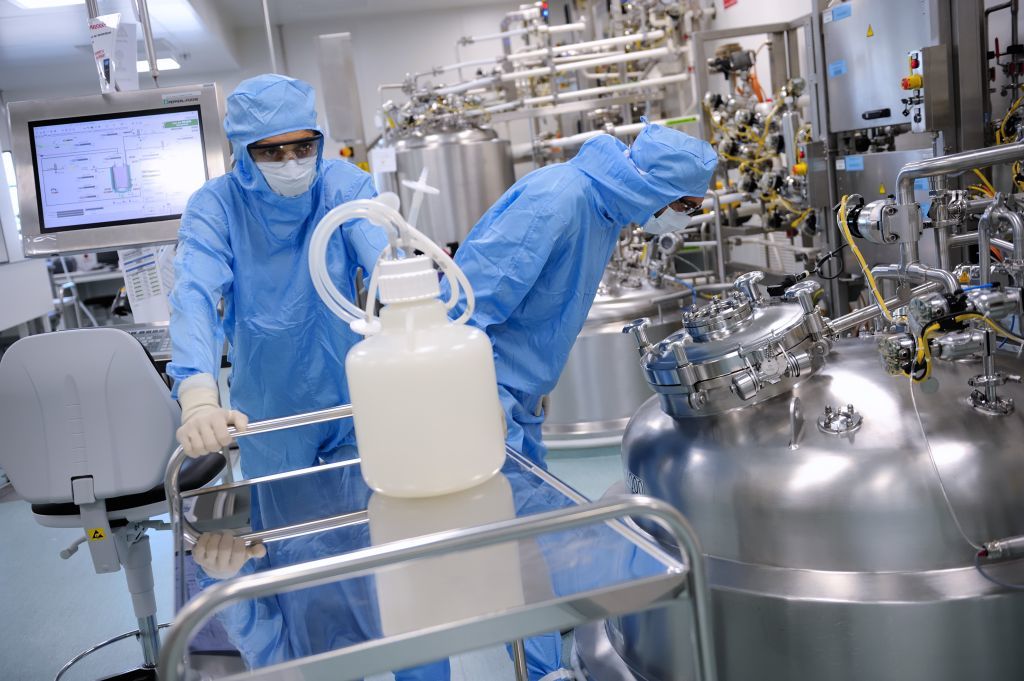
Whether companies are culturing animal cells to make food or drugs, sterility is paramount: a single speck of bacteria can shut down a plant. Left, employees at a manufacturing plant in Neuville-sur-Saône, France, prepare growth media for a vaccine against Dengue Fever.
If even a single speck of bacteria can spoil batches and halt production, clean rooms may turn out to be a basic, necessary precondition. It may not matter if governments end up allowing cultured meat facilities to produce at food-grade specs, critics say—cells are so intensely vulnerable that they’ll likely need protection to survive.
“We’re saying, guys, it has to be pharmaceutical-grade because the process is going to demand it,” Wood told me. “It’s not whether someone will allow you [to run at food-grade specs.] It’s just the fact you can’t physically do it.”
Of course, companies could try. But that might be a risky strategy, said Neil Renninger, a chemical engineer who has spent a lot of time around the kind of equipment required for cell culture. Today, he is on the board of Ripple Foods, a dairy alternatives company that he co-founded. Before that, for years, he ran Amyris, a biotechnology company that uses fermentation to produce rare molecules like squalene—an ingredient used in a range of products from cosmetics to cancer therapeutics, but is traditionally sourced unsustainably from shark liver oil.
“Contamination was an issue” at Amyris, he said. “You’re getting down to the level of making sure that individual welds are perfect. Poor welds create little pits in the piping, and bacteria can hide out in those pits, and absolutely ruin fermentation runs.”
If it’s not clear where the breach is, things can get worse quickly. Renninger said biotech companies sometimes need to take an entire plant apart, scrub everything, and put it all back together again to mitigate an issue—a process that can be necessitated by one tiny eddy in a single piece of pipe welding, which can be “incredibly costly” in terms of labor and lost productivity.
“You can make a big plant, or you can make a clean plant. We need both, and you can’t do that.”
(Renninger received his PhD in chemical engineering from UC Berkeley, where he overlapped with Humbird; he was one of the experts Humbird turned to for feedback on his draft, and is thanked in the paper’s acknowledgments.)
The risks are even more dire when it comes to slow-growing animal cells in large reactors, because bacteria will overwhelm the cells more quickly. At the scale envisioned by proponents of cultured meat, there is little room for error. But if aseptic production turns out to be necessary, it isn’t going to come cheap. Humbird found that a Class 8 clean room big enough to produce roughly 15 million pounds of cultured meat a year would cost about $40 to $50 million dollars. That figure doesn’t reflect the cost of equipment, construction, engineering, or installation. It simply reflects the materials needed to run a sterile work environment, a clean room sitting empty.
According to Humbird’s report, those economics will likely one day limit the practical size of cultured meat facilities: They can only be big enough to house a sweet spot of two dozen 20,000-liter bioreactors, or 96 smaller perfusion reactors. Any larger, and the clean room expenses start to offset any benefits from adding more reactors. The construction costs grow faster than the production costs drop.
For comparison, GFI’s hypothetical plant would have 130 fed-batch reactors and 430 perfusion reactors—a facility that could easily cost over a billion dollars if Humbird’s specs and prices prove to be accurate. But if cultured meat companies can find ways to operate in an environment more like a brewery or restaurant kitchen, that cost might one day be more achievable.
Swartz argued that it’s still unclear whether strict precautions will be necessary, and that more research is needed.
“I think having clean rooms, per se, as they are in biopharma—I’m uncertain if that’s an assumption that should be taken here,” he said. “I don’t know the answers to these questions, and I honestly don’t think anyone does.”
But Humbird said we already know enough to point out a basic, sobering contradiction.
“You can make a big plant, or you can make a clean plant,” he told me. “So if you want to feed millions and millions of people, it’s got to be big. But if you want to do it with animal cells, it’s got to be clean. We need both, and you can’t do that.”
4. The price of (synthetic) blood
When cattle are processed at a slaughterhouse, workers will sometimes cut open a cow’s body and discover a fetus. Dairy cows are kept perpetually pregnant so that they can produce milk, and farms often overlook the animals’ status when they’re finally shipped out for slaughter. Once a living fetal calf is discovered inside a carcass, it’s too late for it to be born. Instead, a technician will be called in who can perform euthanasia and, from there, extract the fetus’s blood.
The resulting substance, known as fetal bovine serum (FBS), amounts to a final gift for humanity. According to an article in the peer-reviewed online publication Bioprocessing Journal, FBS and other animal sera have led to the development of life-saving remedies like cell and gene therapies. It’s also used in some forms of animal cell culture, including the research and development of new vaccines.
Cultured animal protein can’t really be “meat without slaughter” if it’s dependent on an ingredient that’s intertwined with the current, grim realities of commodity beef production.
FBS would be a perfect ingredient to include in cultured meat growth media, because it contains key proteins and vitamins that cells need to maintain health and stability. In fact, it can be hard to make cells grow properly without FBS. “In many common culture media, the sole source of micronutrients is fetal bovine serum (FBS),” according to a 2013 article in the peer-reviewed journal BioMed Research International.
For cultivated meat, though, FBS is anathema. Cultured animal protein can’t really be “meat without slaughter” if it’s dependent on an ingredient that’s intertwined with the current, grim realities of commodity beef production. So cultured meat startups also face the challenge of growing their cells in FBS-free media—though that’s not going to be easy. When the alternative protein company Eat Just was approved to begin selling small amounts of cultured meat in Singapore last year, an event that was hailed as a seismic shift by the industry, it still used a small amount of fetal bovine serum in production.
In order to be viable, cultured meat companies will need to find ways to produce large amounts of product without FBS. For now, though, serum-free media can be both hugely expensive and challenging to develop; in CE Delft’s estimation, its use can ratchet up the cost of cultured meat to well over $20,000 per kilogram. But the GFI-commissioned report also found the cost of cultured meat could drop down to a mere $17 per kilo if the recombinant proteins and growth factors typically supplied in serum could be bought more cheaply. A recombinant protein like transferrin can go for $260 a gram. Growth factors like TGF-β can cost several million dollars a gram, which means they’re more expensive by weight than actual diamonds—though they’d be used in much lower quantities than the proteins. Reduce the cost of these inputs, the logic goes, and the cost of cultured meat can come down almost 90 percent.
But the report provides no evidence to explain why these micronutrient costs will fall, and both Wood and Hughes expressed skepticism that they would.
“They say, oh, but these costs are just going to go away in five years or 10 years,” Hughes said. “And there’s no explanation as to how or why.”
Humbird’s report does project that growth factor costs will go down as the industry matures, simply due to economies of scale. It’s one example of where he left some leeway through a more generous assumption. But he also said there’s a risk that the cost of growth factor production may never come down significantly, even at scale—at this point, no one knows for sure.
“Then we would not be having this conversation at all,” he said. “It’s a non-starter. Analysis over.”
“They say, oh, but these costs are just going to go away in five years or 10 years. And there’s no explanation as to how or why.”
There’s another issue: In focusing on micronutrients as the primary cost driver, GFI may have underestimated the cost and complexity of providing macronutrients at scale. Just like other living animals, cultured cells will need amino acids to thrive. In Humbird’s projection, the cost of aminos alone ends up adding about $8 per pound of meat produced—already much more than the average cost of a pound of ground beef. GFI’s study, on the other hand, reports that the cost of aminos may eventually be as low as 40 cents per kilo.
Why the discrepancy? A footnote in the CE Delft report makes it clear: the price figures for macronutrients are largely based on a specific amino acid protein powder that sells for $400 a ton on the sprawling e-commerce marketplace Alibaba.com. That source, though, is likely not suitable for cell culture. Via a chat tool, I asked the Alibaba vendor if the product would be acceptable for use in pharmaceutical-grade applications. “Dear,” she wrote back, “it’s organic fertilizer.” (In other words, it would not be.) As described on the webpage, the product is intended to be used in crop irrigation systems to help with plant nutrient uptake. The vendor did confirm it would be appropriate to use as an additive in livestock feed.
But nutrition sources like the one sold on Alibaba will probably never work for animal cell culture, despite the attractive price tag. Because they’re not intended for human consumption, they may include heavy metals, arsenic, organic toxins, and so on. That’s a problem. Animal cells lack a rigid cell wall, so foreign substances that aren’t consumed by the cells—or that don’t kill them outright—likely end up inside the cells. In other words, cells are what they eat: If it’s in the feed, it will end up in the cultured meat.
“Even if these contaminants did not directly inhibit cell growth or development in cell-culture media, they would very likely be left behind in the product,” Humbird writes.
That’s not all. Even small variations in the nutritional profile make cells metabolize differently, adding a level of uncertainty that’s unacceptable in a large-scale commercial process. At the same time, tough processing agents, or even naturally occurring plant peptides, can kill cells or limit their growth. Due to sterility requirements, human health considerations, and the biological needs of cells, ordering protein powder off Alibaba probably isn’t going to cut it.
Cells are what they eat: If it’s in the feed, it will end up in the cultured meat.
Swartz couldn’t immediately explain why the Alibaba powder was listed as a suitable raw ingredient in GFI’s report, though he said that the companies involved would have flagged it if they deemed it to be a problem. Still, he acknowledged that amino acids were going to be “a challenge.”
“I think there’s probably going to be some sort of lower bound on how crude of ingredients you can actually put into a cell culture medium,” he said. While he said that some companies have had success reformulating cell-culture medium with food-grade ingredients, that lower limit is still being worked out.
Humbird takes all this to mean that amino acids will need to be produced and purchased individually—a grueling task that he describes in great detail.
Currently, global production of individual amino acids is far too low to support cultured meat production, even at a modest scale. Take L-tyrosine, an essential amino acid, for example: Currently, only 200 metric tons of it are produced globally per year, according to Humbird. To support even modest cultured meat production, we would need to produce six times that—and it would all need to be suitable for cell culture. This essentially means scaling an entirely re-envisioned amino acids supply chain simply to meet demand, starting now.
“There can be no cultured meat scale-up without concomitant and dramatic scale-up of amino acid production,” Humbird’s report concludes.
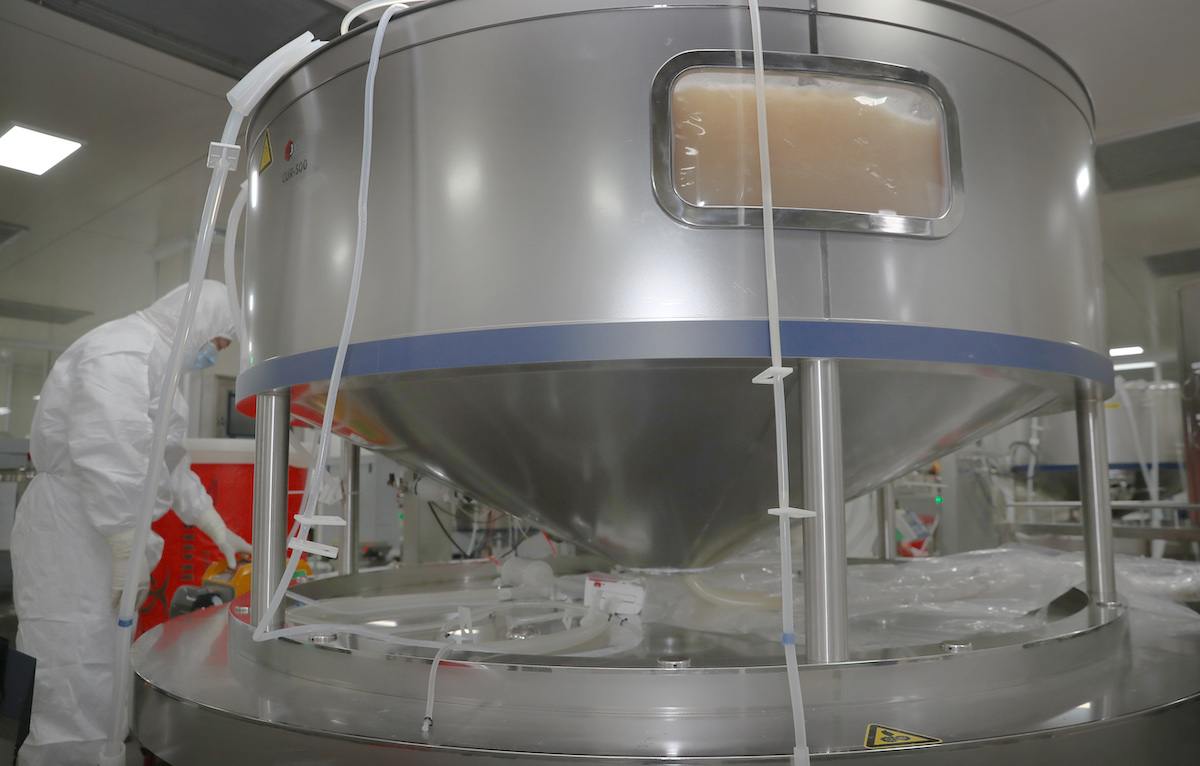
Affordable cell culture media may be dependent on the availability cheap commodity soy—one of the most destructive facets of our agriculture. Left, a researcher attends a tank of growth media to be used for COVID-19 vaccine production in Nantong, China.
Xu Congjun/VCG via Getty Images
There is one faint reason for hope. In his report, Humbird points out that if companies can find a way to derive a full amino acid profile from cheap commodity soy, it could reduce the cost of growth medium macronutrients dramatically. Success on this front is far from assured, however. It could take years of research and development to devise a method of processing soy into forms suitable for cell culture, on a scale large enough to supply the cultured meat industry.
Yet there’s another problem with this approach, one Humbird doesn’t dwell on: It relies on the continued abundance of cheap soy, which as currently produced is one of the most destructive facets of our agriculture. American corn and soy are so cheap only because the U.S. government pays its farmers to over-produce them in vast monocultures—a wasteful, resource-intensive approach to farming that contributes to climate change and water pollution. Elsewhere in the world, soy production is one of the leading drivers of tropical deforestation.
A soy-based approach to cultivating meat would likely entrench this dynamic, since vast quantities of inexpensive bulk product would still be needed. Rather than disrupt the existing paradigm for food production, or help incentivize a pivot to a more dynamic, diversified agriculture, cultured meat fed on soy protein might only further lock us in.
5. “What do you know that we don’t know?”
On June 29, when GFI held an invite-only video call on the future of cultivated meat, it was supposed to be the standard fare: a friendly informational session for industry insiders excited by the technology’s potential. Things did not go as planned.
To kick off the audience Q & A portion of the event, Ricardo San Martin, director of the Alt:Meat Lab at UC Berkeley, began with a skeptical question to Friedrich, one informed by years of research: What do you know that we don’t know? Because, he said, the notion of scaled-up, affordable cell-cultured meat appears at odds with the current science. As San Martin told me later, “I just cannot see it.”
A contentious exchange followed. According to San Martin and another attendee on the call who confirmed his account, Friedrich argued that investor buy-in was the de facto proof that cultivated meat has legs. Major meatpackers, prominent venture capital firms, the government of Singapore: You could trust that these stakeholders had done their due diligence, and they wanted in. He also referred San Martin to GFI’s TEA report, using it to suggest that price parity was possible in the not-so-distant future.
But San Martin kept pressing. In his view, the science is essentially settled: Cultivated meat won’t be economically viable until companies can make cells grow beyond certain widely recognized biological limits. Higher cell density means more meat per batch, which in turn means the number of bioreactors can fall, and the size of the clean room can shrink.
“I’m not saying no one knows how to do it,” San Martin remembered saying. “I’m saying if someone knows, can you please share it with us?” His hope was that Friedrich, whom he has known for years, would simply give an indication that there has been an unprecedented breakthrough at one or more of the companies GFI represents—without disclosing anything about a specific company’s IP, on a call closed to the press. But San Martin said that Friedrich refused to confirm or deny, continuing only to redirect him back to GFI data—the recent uptick in investment dollars, and the scenarios outlined in the TEA report.
A few days later after the video call, when I spoke to him by phone, San Martin sounded disappointed and skeptical. If companies haven’t made progress on cell density, in his view, the whole idea of cultured meat at scale isn’t a business plan: It’s speculation.
“You can play with the numbers as much as you want, but unless you see the fermenters growing the cells at scale, then it’s just a very theoretical scenario,” he told me. “We don’t get straight answers from the companies. They don’t have to share with us, because we are a university—what’s the point of sharing with us? But it would be nice to know that someone has done it at scale, not in a little shaker. At scale. No one has ever published something saying we can do this at scale at this many cells per ml, and we do it using this trick and this trick.”
What’s more likely, then, is that companies are still struggling with an inherent, widely documented challenge: the cells’ tendency to limit their own growth. Like all living things, animal cells in culture excrete waste. These so-called catabolites, which include ammonia and lactate, are toxic and can slow cell growth even at low concentrations. As San Martin puts it, “they get inhibited by their own poo-poo.”
“In cell culture for biopharmaceuticals, accumulation of toxic catabolites is a more frequently encountered limit than any physical limit of the bioreactor itself,” Humbird wrote.
The waste issue can be addressed, but the solutions introduce new problems. Catabolites can be repeatedly cycled using perfusion reactors, but that approach is likely not financially viable because—as Humbird points out—it requires smaller vessels and much more square footage, limiting economies of scale. The other option is to engineer new cell lines that excrete less while still growing quickly. Humbird told me that these two goals stand in contradiction to one another, in accordance with a basic principle of thermodynamics: Slower-growing cell lines tend to metabolize more efficiently, while faster growing cell lines tend to produce more waste.
This challenge should sober any investor. Even the legendarily efficient and versatile Chinese hamster ovary cells—an immortalized cell line which has benefitted from more than 60 years of constant research and development—is “probably not efficient enough for low-cost production of bulk cell mass,” according to Humbird.
Maybe cell lines optimized specifically for food production will fare better in time. Still, the cell density issue is one of the most intractable problems this emerging industry will face. Considering that the pharmaceutical industry has already likely spent billions on this very challenge—sums that make the total investment seen in cell meat look like a drop in the bucket—solving it would be a stunning accomplishment. It would be a David and Goliath story of the most gripping and impactful kind: A fledgling industry musters an unthinkable scientific breakthrough that entrenched power players have been chasing for years, and in a shorter time period, with just a fraction of the cash.
But Paul Wood suggests a different example from world literature, one he thinks describes the reality better.
“To me this sounds like the story of the Emperor’s Clothes,” he wrote, in an email. “It’s a fable driven by hope, not science, and when the investors finally realise this the market will collapse.”

6. The terror of trial and error
You could be forgiven for thinking that cell-cultured meat is imminent. On Monday, Eat Just revealed that its cultured meat line, GOOD Meat, had raised another $97 million, on top of a $170 million raise announced in May. That comes after last month’s news that Eat Just is preparing to open a large-scale cultivated meat plant in Doha, Qatar, in partnership with two state-backed organizations—Doha Venture Capital, a VC firm, and the Qatar Free Zones Authority (QFZA). QFZA oversees Qatar’s economic “free zones,” designated areas that boast business-friendly incentives like zero corporate tax rates and duty-free exports. Strategically located near Doha’s airport and port, a successful factory would give Eat Just access not only to Middle Eastern markets, but to the world.
“Right from the beginning, we are looking at what the export plan is,” Lim Meng Hui, QFZA’s CEO, told Bloomberg News.
When Friedrich suggests that governments should support the development of cultivated meat, this is the kind of arrangement he’s talking about. The Qatari Investment Authority, the nation’s sovereign wealth fund, which led a separate $200 million investment in Eat Just earlier this year, will help to cover a significant chunk of the facility’s capital costs, according to Bloomberg. Between the corporate incentives and the strategic location, the Qatari partnership theoretically positions Eat Just to produce cultured meat at scale and export it all over the globe.
And yet when I spoke to Eat Just’s CEO, Josh Tetrick, he readily admitted that there are still many unknowns—including reckoning with the same challenges Humbird outlines in his report.

The truth is no one really knows if cultured meat production is truly feasible at scale. Eat Just’s cultured chicken, left, was hailed as a historic milestone when it first went to market—but the company has only sold a few hundred pounds so far, and at a financial loss.
courtesy of Eat Just
“A number of significant engineering challenges will need to be accomplished,” Tetrick said, with a bluntness that surprised me. “We have a high-quality engineering team. We have sufficient capital to be able to get after this. We understand what the challenges are, and if we’re successful in handling these challenges, we’ll put ourselves in a place where we can do this. And if we don’t, then we won’t. I think that’s just the reality of it.”
If we don’t, then we won’t. I wasn’t sure I’d ever heard a CEO so readily admit that a promised product—in this case, one that Eat Just has raised hundreds of millions of dollars to produce in the last six months alone—might simply not be possible.
Tetrick spoke to me by phone from the Hawaiian island of Kauai, where he had been working remotely. Wild chickens roamed nearby, and occasionally their noise would break in on the call—a strange, living backdrop for a conversation about the dream of culturing chicken cells en masse. The irony wasn’t lost on Tetrick.
“As I’m talking about this, they’re hearing me,” he laughed. “Thinking, ‘No, you better make this pretty fucking certain.’”
But as I learned more about Eat Just’s plans, it became clear that uncertainty was the only logical stance. Tetrick said that the Doha facility will need to be a large facility, and that the company defines “large” as being able to produce 10 million pounds of meat a year. That’s only about two-thirds of the output of Humbird’s hypothetical facilities, and less than half of GFI’s. But those facilities are projections; they don’t yet exist. There has never been a facility on earth that can produce cultured animal cells at that kind of volume—not in biopharma, and not anywhere. For comparison, Eat Just’s much-hyped cultured meat operation in Singapore currently produces hundreds of pounds of meat per year, and in a 1,200-liter reactor.
To make the 10-million-pound goal feasible, Tetrick said, production will need to take place in vessels that are 100 cubic meters or larger. That scale is hard to fathom. A 100-cubic-meter bioreactor would hold 100,000 liters and could easily be 20 feet high; Tetrick says he’ll need 15 of them. The result would be a gleaming, miniaturized city of smaller, seed-scale bioreactors leading sequentially to a cluster of massive vessels in the middle, metaphorical high-rises filled with medium and meat.
Production on this scale is still highly theoretical. “I can’t go to any company that engineers bioreactors and say, ‘Can you please deliver a 100,000-liter reactor to this location in Doha in three months,’” Tetrick said. “What they would say to me is, ‘We have never, nor has any company in the world ever, designed and engineered a 100,000-liter reactor for animal cell culture. This has never happened before.’”
It may never happen. According to Renninger, there’s a reason why the biopharmaceutical industry’s largest bioreactors for animal cell culture tend to peak at about 25,000 liters.
“It’s not so much that it’s just never been done. It’s that it’s never been done because it doesn’t make sense,” he said. “It’s never been done because you can’t. You’re just going to be producing vats of contaminated meat over and over again.”
Due to cells’ slow growing time, Renninger said, contamination in large reactors will need to be close to zero. And, he added, “Zero is not a thing that exists.”
Sterility isn’t the only challenge that becomes more grave at larger production volumes. Bigger bioreactors all also struggle to provide all of the cells with the same amount of nutrients and oxygen. The only solution is to stir the cells more rapidly, or blow more oxygen in—but both of these approaches can be fatal. Because they lack a rigid cell wall, animal cells are prone to “shear stress”; they’re fragile little things that can are easily torn apart by rising air bubbles, cell-to-cell collisions, and rotating impellers. This need for increased stirring and oxygen has historically put practical limits on bioreactor size—a problem that remains unsolved at scales well below what Tetrick envisions.
“When cells die in large quantities, they kind of turn into this kind of slimy stuff that’s really horrible,” Hughes told me. “You really can’t afford to have that happen.”
Solving these interlinked challenges will require more than engineering prowess. It’s going to require lots of money and nerves of steel—because trial and error at the 100,000-liter scale could result in enormous development costs. A bioreactor that size might cost $20 million and take 12 months to build, Humbird said. And there’s no way to know if cells will perform as desired inside it. You can use AI for modeling up until a point, but eventually companies will have to make a leap of faith and try a white-knuckle, real-life process known as “destructive testing.” If the process fails badly enough, they could be forced to kiss their brand-new reactor goodbye and go back to the drawing board.
“It’s never been done because you can’t. You’re just going to be producing vats of contaminated meat over and over again.”
The notion of trial-and-error on this scale is mind-boggling. “It’s something even the biopharmaceutical industry couldn’t bring itself to do,” Humbird said.
It’s a bridge Tetrick will have to cross if his massive vessels are ever going to become a reality. At 1,200 liters, the largest reactor size his company has produced in to date, Tetrick said things are working beautifully: The cells are thriving on the serum-free media Eat Just has developed, and cell slurry is being produced. But beyond that scale, little can be taken for granted.
Tetrick seemed sanguine about the prospects, but I sensed he nonetheless recognized the severity of the challenge. He described the process as a series of informed bets, using a combination of modeling and real-world observation to decide whether the next stage of magnitude is a risk worth taking.
“If companies in the cultured meat space are not individually comfortable with taking informed bets on the allocation of many tens of millions of dollars of capital, they should probably be in another line of work,” he said.
As he went on, it became clear that Tetrick really does believe that affordable, abundant cultured meat is inevitable. Just not necessarily in our lifetimes.
“I believe in the next hundred years it is certain that the vast majority of the world’s meat will be made this way,” he said. “What is very uncertain is whether that will be the case in the next 30 years. The answer to that lies in this question of: Are we able to build this infrastructure? Are we able to nail it? Or do you have enough companies making informed bets? Obviously, we hope that ends up paying off, but there’s some real risk that it won’t. And that would be a real shame.”
7. Moving the goalposts
Already, there are signs that cultured meat startups have tempered their expectations. The industry’s early, heady days were flush with optimism. Co-founders spun visions of giant bioreactors effortlessly cranking out meat, and investors had dollar signs in their eyes—even displacing a modest fraction of the trillion-dollar global meat industry could mean making billions. Now, despite GFI’s soaring rhetoric, some companies are quietly—or overtly—planning for a much more modestly disrupted future.
“I think we agree with your basic premise,” Justin Kolbeck, co-founder and CEO of the San Francisco-based cultured seafood startup Wildtype, told me, after I explained the objections I’d been hearing from cultured meat’s critics. “When we started Wildtype, we never thought—at least in the near- or medium-term—that the seafood products that we would produce would completely eliminate or even extraordinarily reduce the need for conventional seafood production.”
Instead, he sees the industry as something that will grow as the world population does—hopefully being just one part of a number of different solutions, including plant-based imitation meats, that will help to meet the world’s growing appetite for animal protein. He and his co-founder Aryé Elfenbein agreed that cultivated meat is likely to be expensive and scarce for the foreseeable future—and Wildtype has a business model to match.
“We never thought—at least in the near- or medium-term—that the seafood products that we would produce would completely eliminate or even extraordinarily reduce the need for conventional seafood production.”
“People are used to paying a lot of money for sushi products,” Kolbeck said. “The difference between what we need to make our costs be for a piece of high-grade salmon or tuna sushi are a couple of orders of magnitude larger than chicken. I have a really hard time believing in the next five years that we’re going to have a chicken burger that’s at the same cost of conventional chicken products. I think we’re more likely to show up in places like your favorite sushi restaurant, where you’re used to paying a little bit more for fish and you might already be in an exploratory sort of state of mind for trying something new.”
Wildtype is currently trying to get its costs for cell-cultured fish down from hundreds of dollars a pound to five or six dollars a pound. The company plans to open a tasting room in San Francisco, where its small production facility will sustain a tourism of cultured meat—intrigued customers will pay for an experience that the market elsewhere can’t support.
Future Meat Technologies, an Israeli startup that has reported receiving $45 million in investment capital, is taking the opposite approach to Eat Just: It wants to use smaller perfusion reactors that cycle out waste material, and it has developed a process that also allows for protein and other nutrients to be cycled back in. These factors help to cut down the volume of media needed, leading to what sound like impressive results: $18 to produce a pound of cultured chicken, according to a press representative.
That’s the lowest real-world figure I heard in the course of reporting this story, but it doesn’t reflect the technology’s full cost. According to Future Meat’s chief science officer, Yaakov Nahmias, the $18 figure only includes the price of growth media, consumables, and utilities. In an email, Nahmias said that the company is rapidly driving down the cost of nutrients in its solution, and is finding new ways to use less media overall. Still, the cost of buildings, construction, equipment, installation, labor, and other factors will eventually need to be reflected in the price of Future Meat’s products if the company is ever going to be profitable.
That’s where an approach based on perfusion may become challenging. Cultured meat companies can really only chase three economies of scale: lower costs for media ingredients, more efficient cells, or larger bioreactors. Future Meat has already closed the door to the last option. Working with perfusion reactors likely means putting hard limits on the scale of a facility; their smaller size means many more bioreactors are needed overall, which means more capital expenditure costs and a larger clean room.
That may be why, in the 2019 podcast, Nahmias said he didn’t see large-scale facilities in cultured meat’s future.
“You don’t want to build these mega-factories outside the cities to feed everybody,” he said. “You want to make sure that the technology is able to be distributed.”
From there, he went on to imagine a scenario where farmers and ranchers pivot away from livestock and instead take on their own bioreactors, cranking out several thousand pounds of cultivated meat each year (and, I assume, paying a license fee to Future Meat for use of its tech). Others can debate whether or not that approach is practically feasible, though sterility control and the lack of specialized training would seem to be major obstacles. The larger problem is economic. Without scale and centralization, cultured meat will be no different from any other food production method: expensive.
In my conversations with Swartz, it became clear: GFI believes that these more expensive, exclusive approaches will be enough for cultured meat to gain a foothold with consumers. A certain number of wealthy, adventurous, and conscientious eaters could sustain a modest market. If the industry can hang on long enough catering to those early adopters, then maybe it will be able to innovate further before investors lose interest and capital stalls out.
We already have a food system where people with enough means can pay for meat from “happy” animals. Smaller-scale cultured meat would likely only extend that logic: You can pay extra to know your meat never lived at all.
Isha Datar, executive director of New Harvest, a nonprofit research institute devoted to advancing cultivated meat, said it’s not fair to compare cultured products to current meat prices anyway. In her view, the traditional meat supply chain is only going to become more precarious and expensive as resources like land and water become scarce on our increasingly crowded and over-heated planet.
“We can’t really assume that animal agriculture is going to continue the way it has because it has faced such outsized hardship,” she said, pointing to the way that the traditional meat supply chain crumpled when the pandemic hit, while sales of plant-based burgers soared. “I can only see the price of cultured meat coming down, and I can only see the price of meat from animals going up, in a changing world.”
She may be right. And yet, cultivated meat might still be too expensive to make sense in the regions where population is growing fastest. Based on his experience on the board of the Global Alliance for Livestock Medicines, a Gates Foundation-funded nonprofit that supports people in Africa, India, and Nepal who rely livestock for their livelihood, Wood feels that the solutions proposed by cultured meat advocates are hopelessly out of touch with the needs of the developing world.
“These are not solutions for these people,” he said. “So in this whole debate around the future of food, we’re ending up with solutions that fit wealthy, middle-class people who want more options. I’ve got nothing against it, but don’t pretend it’s going to solve world food. That’s the thing I find most offensive.”
We already have a food system where people with enough means can pay for meat from “happy” animals. Cultured meat on a smaller scale would likely only extend that logic. Namely, that if you’re rich enough, you can pay to know that your meat didn’t die a painful death—in fact, that your meat never really lived at all.
8. The price of failure
On September 14, President Joe Biden visited NREL, the federally funded renewable energy lab that contracts Humbird for due diligence analysis. With a row of solar panels, a windmill, and a view of the Rocky Mountains behind him, Biden argued that the next 10 years will be “a decisive decade,” underscoring the need for new infrastructure in a live-streamed address.
“We don’t have a lot of time. We don’t have much more than 10 years,” he said.
Biden described viewing the wreckage of California’s devastating Caldor fire by helicopter, just days after traveling to Louisiana, New York, and New Jersey to see the destruction from Hurricane Ida. He talked about mudslides washing out a section of Colorado’s I-70 highway, and about parents being afraid to let their children play outside when the air is filled with smoke. He talked about the droughts decimating agricultural communities, and the tropical storms battering cities across the eastern seaboard. He said that 44,000 wildfires had razed 5.6 million acres of U.S. land this year alone, “the size of the entire state of New Jersey burned flat.”

President Joe Biden visited the National Renewable Energy Laboratory (NREL), a federally funded research center in Golden, Colorado, on September 14, 2021. He underscored the harrowing new climate reality we’ll confront if we don’t act now. But should cultured meat be part of the solution?
Werner Slocum / NREL
This, Biden underscored, is only the beginning of the harrowing new reality we’ll confront if we don’t act. We need to start now—“today, not next year, or not 10 years from now,” he said.
How should we spend the next decade, the brief window we have to reinvent our relationship with the climate? For Biden, the choice is apparently clear. After all, we already know how to slow the worst effects of climate change: We need to stop burning fossil fuels, replacing them with other alternatives as quickly as possible. It’s an achievable goal, in theory. Renewable energy technologies, while they can still be improved and made cheaper, already exist.
“These technologies aren’t science fiction,” Biden said, speaking of the state-of-the-art solar panels, windmills, and batteries developed at NREL. “They’re ready to be installed and scaled up across the country right now.”
That rebuilding will need to happen anyway if cultured meat is ever to be a solution.
Cell culture facilities are resource-intensive—and critics argue that, if powered by fossil fuels, their environmental footprint could be even worse than that of traditional meat. GFI’s own life-cycle analysis found that cultivated meat could have worse climate impacts than some forms of chicken and pork if conventional energy is used.
But some would choose a riskier path. Earlier this year, in an issue of the food lifestyle magazine Eating Well that named him an “American Food Hero,” Friedrich lamented that the U.S. government put only $5 million into alternative protein research, including for cultured meat, in 2020.
“That number should be billions,” he said.
We can argue about the validity of that strategy. But first we need to be more honest about the possibility of success.
Cell culture facilities are resource-intensive—and critics argue that, if powered by fossil fuels, their environmental footprint could be even worse than that of traditional meat.
When GFI claims that cultured meat can be cost competitive by 2030, it gives the sense that a radically reshaped future is rushing toward us. It has used that finding to suggest that the train is leaving the station—that the necessary innovations have already occurred, that the outcome is inevitable, and the only question is whether you’re in or out. Each new investment, each incremental improvement, is hailed as a historic world first, evidence of a turning tide.
It’s easy to get swept up in that sense of possibility. I know, because the media does it, too. Cultured meat is tantalizing in its disruptive potential. The players are charismatic, even visionary in their language; there are tastings to enjoy, lab-grown samples to chew and ponder. The themes—old versus new, upstart versus incumbent, synthetic versus natural—have rich, universal appeal. It’s been so easy to dwell on the radical novelty of it, enhancing our shared sense of the world sliding toward an unfamiliar future. Maybe the arc of history really does bend toward progress. Why reckon with the technical challenges involved, when we can daydream collectively about the potential of meat without slaughter, of eating without guilt, of consumption without consequences?
But the truth is this: For cultured meat to move the needle on climate, a sequence of as-yet-unforeseen breakthroughs will still be necessary. We’ll need to train cells to behave in ways that no cells have behaved before. We’ll need to engineer bioreactors that defy widely accepted principles of chemistry and physics. We’ll need to build an entirely new nutrient supply chain using sustainable agricultural practices, inventing forms of bulk amino acid production that are cheap, precise, and safe. Investors will need to care less about money. Germs will have to more or less behave. It will be work worthy of many Nobel prizes—certainly for science, possibly for peace. And this expensive, fragile, infinitely complex puzzle will need to come together in the next 10 years.
On the other hand, none of that could happen.
“It’s a fable driven by hope, not science, and when the investors finally realize this the market will collapse.”
Swartz insisted that the prospect is worthy of a gamble. While he didn’t dispute the specific challenges outlined in Humbird’s report, he said that GFI sees them differently: not as inherent limits, but as opportunities for growth.
“The things that we talked about today are open questions and they’re fair to raise questions about, including the tractability of how fast we can actually get there,” he said. “I don’t think these limitations should be interpreted as obituaries for the industry, though. Innovation, and new ideas, and new research and development efforts, can go a long way toward addressing challenges that people never thought could be achieved.”
But Renninger finds it “frustrating” to see so many resources going into cultured meat.
“It is a zero-sum game, to a certain extent,” he said. Money we spend chasing cultured meat is money we can’t use on converting coal plants to biomass, or scaling solar and wind, or modernizing concrete and steel.
There’s a reason that the U.S. government employs people like Humbird to do rigorous due diligence on attractive new ideas. When billions are spent on science that doesn’t come together, the biggest losers aren’t really the private companies and trade associations, or the class of professional investors who get rich on speculative tech. Instead, the public loses out—and we lose time we don’t have.
As Humbird put it, “If society pays for it and it doesn’t work out, then society’s left holding the bag.”
The environmental ravages we face are vast, destabilizing, and encroaching on our real lives right now. The fires, the floods, are already at our door. In all this, it would be so good to know we have a silver bullet. But until solid, publicly accessible science proves otherwise, cultured meat is still a gamble—a final trip to the casino, when our luck long ago ran out. We should ask ourselves if that’s a chance we want to take.


